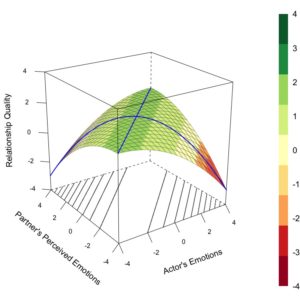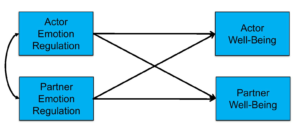Topics of Study
Supportive and satisfying relationships are among the most important factors contributing to our well-being. While we often seek to care and connect with others at a deeper level, we may do so in ways that at times help, and at other times hinder, our relationships and well-being. In our research, we seek to understand how caring and connecting with others shapes personal and relationship well-being, with a specific focus on emotions, motivation, and character strengths and virtues.
Emotion Regulation and Perception

An important component of well-being concerns how people regulate their emotions. Whether it is withholding anger from a spouse during an argument or exaggerating excitement in order to provide positive feedback to a child, our relationships require that we control both desired and undesired emotions. What is the right balance of authentic expression and emotion regulation? Further, how does the accurate–or inaccurate–perception of our relationship partners’ emotions impact well-being? In our lab, we seek to understand how the regulation and perception of emotions helps versus hurts relationships.
Motivations in Relationships

In our relationships, we often have the challenge of balancing self-oriented goals to pursue personal benefits with other-oriented goals that support our relationship partners. Being other-oriented, such as having a communal motivation to care for others, can help build new relationships and foster existing ones. While motivations to care can bring us closer to others, they also make us vulnerable to the potential risks of being hurt or exploited. In our lab, we seek to understand when the motivation to care for others is beneficial versus costly to our personal and relationship well-being.
Character Strengths and Virtues
Across societies, there are many character strengths and virtues that we value and seek in relationship partners. While we value qualities such as honesty, hope, and kindness, these characteristics may have varied effects on relationships based on context. For instance, while honesty may promote intimacy and help us come to know one another, disclosing undesirable or threatening information may hurt those closest to us. Further, while hope and kindness may promote positive feelings among partners, there may be times when these positive processes are misplaced. In our lab, we seek to understand and identify contexts in which character strengths and virtues promote relationship well-being.
Interpersonal Relationships

We study a range of interpersonal relationships, with a specific focus on romantic and parent-child relationships.
Methods and Statistics in the Lab
Our lab uses a combination of survey and observational methods to study relationships. Surveys allow us to understand people’s subjective relationship experiences in daily life, during interactions in the lab, and over time. We also engage in observational coding to assess the behavior individuals outwardly express in their relationships. We use a variety of statistical techniques to analyze the data we collect, including multiple regression and multilevel modeling. In addition, we use a few other advanced methodological and statistical techniques:


Daily experience studies allow us to capture people’s relationship experiences as they unfold naturally in day-to-day life.
 Longitudinal methods are used to understand how relationships and well-being change over time.
Longitudinal methods are used to understand how relationships and well-being change over time.

Response surface analysis allows us to understand how the combination of each partner’s emotions (or motivations) predicts personal and relationship well-being.

Actor-Partner Interdependence Modeling allows us to understand how one person’s emotions (or motivations)–accounting for their partner’s emotions (or motivations)–can shape each person’s well-being.

Meta-analysis allows us to synthesize results from multiple studies to obtain a reliable and comprehensive estimate of an effect of interest.

We incorporate open science practices into our work to facilitate transparency and replicability of our research.
